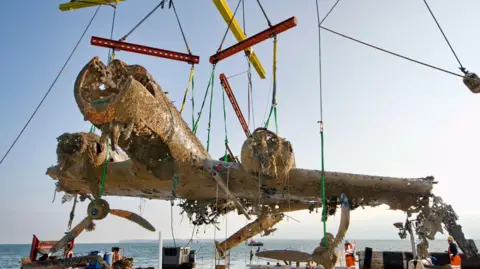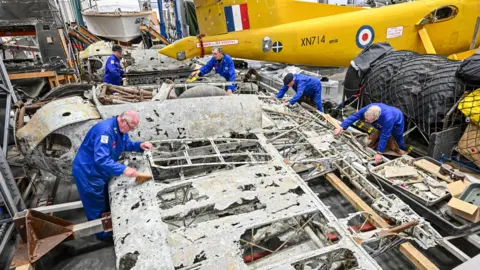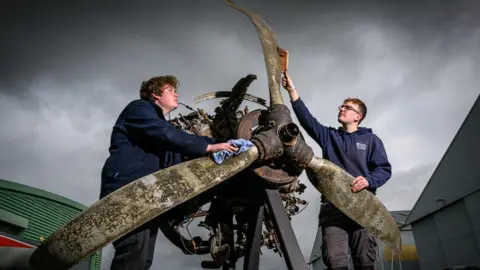Salvaged WW2 plane display set to give you wings
 RAF Museum
RAF Museum"A remarkable moment for aviation history in Britain" is about to give you wings - and it's all down to the salvaging of a World War Two aircraft from the bottom of the sea; the restoration project almost as storied as the plane itself.
An iconic Dornier Do 17 - nicknamed The Flying Pencil for its slender body - is set to go on public display at RAF Museum Midlands, Shropshire, in early 2025. Or at least parts of it are - the wings section, plus engines and propellers.
The whole craft - deployed by the German air force, the Luftwaffe - was recovered in waters off Kent after being shot down by the RAF decades earlier. It is the only complete example anywhere. But the plane is nevertheless in pieces, with the parts, which are kept at the venue, subjected to painstaking work to reverse the corrosive effects of sea water.
But now after more than a decade of restoration, wings and things are to be unfurled.
The aircraft type was a key feature of the early stages of WW2.
"After more than ten years of intensive conservation, treatment and stabilisation," the display would represent "not only the culmination of an extraordinary salvage operation but a unique way of understanding the Battle of Britain," said Dr Harry Raffal, head of collections and research at the attraction in Cosford.
He added: "This is a remarkable moment for aviation history in Britain."
But how did it all come about?
What's the history of the Do 17?
 RAF Museum
RAF MuseumMore than 1,500 of the bombers were produced, and more than 400 were deployed by the Luftwaffe.
Today, only one remains complete - the one in Cosford.
This individual plane was shot down in August 1940 by an RAF Boulton Paul Defiant - an aircraft type manufactured in nearby Wolverhampton.
The Do 17 wreckage spent more than 70 years on the seabed beneath the waters of Goodwin Sands, Kent.
It was recovered in an operation led by the museum in June 2013.
What happened next?
 RAF Museum
RAF MuseumFollowing the recovery, the plane's body, wings section, propellers and engines were placed in hydration tunnels.
They were sprayed with a low-concentration citric acid solution, to remove marine sediment and neutralise any corrosive impurities.
Once this was done, the body was removed from the tunnels in September 2014, followed by the wings and engines in January 2015.
Since then, the Do 17 has been kept in the museum's conservation centre, where it remains today.
What about the wings and things?
 RAF Museum
RAF MuseumThe museum said the wing section would be on display to the public from early 2025, subject to suitable weather conditions for the move.
While the fuselage will remain in storage for the time being, owing to space constraints in the display hangars, the new year will also see the propellers and engines going on show.
Those parts will be situated alongside not only the wings, but a Boulton Paul Defiant - "the very type that delivered the final blows to this Do 17", said Dr Raffal.
"Our audience will see first-hand the thin edge of technology which enabled the RAF and Luftwaffe to fight out the most important battle of a generation."
Follow BBC Shropshire on BBC Sounds, Facebook, X and Instagram.
